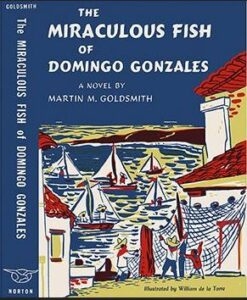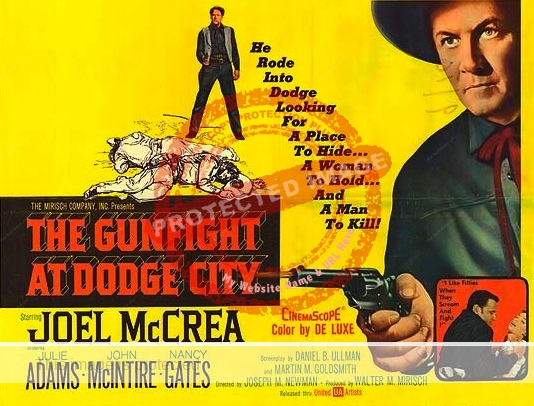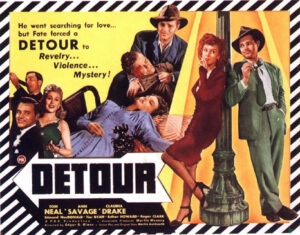Author Martin M. Goldsmith was born 6 November 1913 in New York City and died in Sherman Oaks, Los Angeles, at the age of 80, on 24 May 1994. He wrote several acclaimed screenplays, including Detour (1945), adapted from his 1939 novel of the same name; Blind Spot (1947); and The Narrow Margin (1952) which earned him an Academy Award nomination.
 He and his wife – Estela Quinn-Oaxaca (sometimes known as Stella), the younger sister of movie star Anthony Quinn – lived in Ajijic for a short time in the mid-1960s, while he was working on scripts for the TV series The Twilight Zone (1964).
He and his wife – Estela Quinn-Oaxaca (sometimes known as Stella), the younger sister of movie star Anthony Quinn – lived in Ajijic for a short time in the mid-1960s, while he was working on scripts for the TV series The Twilight Zone (1964).
Goldsmith, born and raised in New York City, left school at the age of 15 and spent several months hitchhiking and hopping freight trains across the U.S. By his early twenties, Goldsmith was selling the occasional story to magazines, and had moved to Mexico, where he wrote his first book, a crime novel entitled Double Jeopardy, published in 1938. By this time he was back in New York and about to move to Hollywood.
Once in the film mecca, Goldsmith took a job as a stage hand to get a close-up look at how movies were made. He completed his second novel, Detour, which was published in 1939. In 1944 Goldsmith sold the film rights to the Producers Releasing Corporation (PRC), with the proviso that he write the screenplay. Using Goldsmith’s meticulously detailed screenplay which included lighting and camera angles, director Edgar G. Ulmer was able to shoot the entire movie in less than a week. The 1945 movie is now recognized as a film noir classic and was added to the National Film Registry in 1992.
Thereafter, Goldsmith and his wife seldom lived in any one place for very long, preferring an itinerant life to staying in the Hollywood limelight.
 For a time, the couple returned to Mexico. His screenplay The Lone Wolf in Mexico (1947) is about a good-natured jewel thief, while a coastal fishing village became the setting for his well-received comic novel The Miraculous Fish of Domingo Gonzales (1950). The Kirkus Review compared “this light, satiric, fanciful fable of the coming of civilization (from America) to Puerto Miguel (Mexico)” favorably to Steinbeck’s Tortilla Flat, concluding that it was “a pleasantly entertaining chronicle of the doubtful benefits of today’s advancements”, with “a bubbling sense of local character and event”. The novel is set in a small, sleepy fishing village which is “developed” (and in danger of being corrupted) when an American buyer of shark livers comes to town to do business with laid-back, deadbeat shark fisherman Domingo Gonzales.
For a time, the couple returned to Mexico. His screenplay The Lone Wolf in Mexico (1947) is about a good-natured jewel thief, while a coastal fishing village became the setting for his well-received comic novel The Miraculous Fish of Domingo Gonzales (1950). The Kirkus Review compared “this light, satiric, fanciful fable of the coming of civilization (from America) to Puerto Miguel (Mexico)” favorably to Steinbeck’s Tortilla Flat, concluding that it was “a pleasantly entertaining chronicle of the doubtful benefits of today’s advancements”, with “a bubbling sense of local character and event”. The novel is set in a small, sleepy fishing village which is “developed” (and in danger of being corrupted) when an American buyer of shark livers comes to town to do business with laid-back, deadbeat shark fisherman Domingo Gonzales.
Both Martin and Estela had pilots’ licenses, and whenever they had the funds and the opportunity, they would travel. They lived in numerous different countries, leading to significant gaps between Goldsmith’s credits. From the mid-1960s on, Goldsmith and his wife spent more time traveling than writing.
In 1964, we learn from Anita Lomax, writing in the Guadalajara Reporter, that “noted Hollywood writer Martin Goldsmith and his wife Estelita (a sister of Anthony Quinn) who flew here in their Piper Comache … are staying a while with us in Ajijic at Casita Mas o Menos”. Three years later, Lomax reported that another Hollywood couple, “Abner and Sybille Bidderman” [Biberman], who had first heard about Ajijic from the Goldsmiths, were visiting Ajijic.

Martin Goldsmith wrote more than a dozen screenplays, including Dangerous Intruder (1945); Detour (1945); The Lone Wolf in Mexico (1947); Blind Spot (1947); Shakedown (1950); The Narrow Margin (1952); Mission Over Korea (1953); Overland Pacific (1954); Hell’s Island (1955); Fort Massacre (1958); The Gunfight at Dodge City (1959); Cast a Long Shadow (1959); Point of Impact (1959); and Narrow Margin (1990).
His TV scripts included episodes of Playhouse 90 (1958); Natchez (1958); Goodyear Theatre (1959); and The Twilight Zone (1964).
Goldsmith’s books included Double Jeopardy (1938); Detour: an extraordinary tale (first published in 1939); Shadows at Noon (1943), a fictional account of an enemy attack on Manhattan; and the comic novel The Miraculous Fish of Domingo Gonzales (1950). He also wrote Night Shift, a stage play which ran for 24 performances at the Labor Theater in New York in the fall of 1977, and an autobiography which was never published.
According to Richard Doody, when Goldsmith’s publisher asked him what to tell his readers about his life, “the author replied that it was enough to say that he was there yesterday, here today and “… God knows where I’ll be tomorrow.””
After a prolonged period of declining health, Martin M. Goldsmith died on 24 May 1994.
Sources:
- Richard Doody. 2005. “Martin M. Goldsmith, Author of “Detour”” –
- Bruce Eder. Undated. “Martin G. Goldsmith Biography” (link available only in US).
- Anita Lomax. Guadalajara Reporter. 16 April 1964; 15 Apr 1967
Sombrero Books welcomes comments, corrections or additional material related to any of the writers and artists featured in our series of mini-bios. Please email us or use the comments feature at the bottom of individual posts.
Tony Burton’s books include “Lake Chapala: A Postcard History” (2022), “Foreign Footprints in Ajijic” (2022), “If Walls Could Talk: Chapala’s historic buildings and their former occupants” (2020), (available in translation as “Si Las Paredes Hablaran”), “Mexican Kaleidoscope” (2016), and “Lake Chapala Through the Ages” (2008).

Very interesting! I’ve recently come across a beautiful collection of many paintings from Ajijc…framed at Casa Ramos probably late 60-70’s. Two of the pieces are by Todd Karns the actor.
Keeks, Thanks for your message. I’d be interested to know which artists you have examples of, and would be interested in seeing photos if possible. If you prefer to respond via email, please use the email of infoATsombrerobooks for initial contact. Thanks, TB
In the mid 1950’s, I had the pleasure of visiting
Martin, Estella, & Raoul, her son, and grandma
in the Echo Park area of Los Angeles. I was
welcomed into the family by the friendliest and
kindest people in the world. Martin gave me my
first experience flying in his Piper (Commanche).
Sometimes I would peek over Martin’s shoulder
as he typed scripts for TV shows. Even I, as a
novice to screen writing, saw the extreme details
he typed into the scripts to guide the directors and
the actors. He would have made an excellent film
teacher in college.
I was sad to see of Martin’s passing, he was a real
good guy.
Allan Miller-tanukiunlimited@me.com
Thanks for your interesting and informative comments. How wonderful that you got to spend time with him and his family. I’m sure he would have been a fascinating dinner party guest. Thanks again, TB.
What a wonderful article, very interesting… I published M.M. Goldsmith’s two “Twilight Zone” scripts, which Estela provided, in my “Forgotten Gems from the Twilight Zone” Volume 2 in 2006. I was glad to get to know her, ever so briefly. I didn’t realize that she was Anthony Quinn’s sister, nor did I realize she was a licensed pilot along with her husband. He was a very talented writer who had a very colorful life!!
There is a slight typo above – Abner and Sybil *Biberman* (not Bidderman) visited Ajijic. Abner was a fantastic actor – many remember him for his memorable role in “Gunga Din” (1939). He later became an acclaimed director. He directed some episodes of “Twilight Zone”, although not the two by Goldsmith.
Andrew, Thanks for the kind words and for pointing out the typo, which was in the original newspaper source and has now been corrected. Greta to learn more about the Bibermans and realize just how important they were. Best, Tony.
Oh also, on the list of many Goldsmith screenplays, there are two that are listed erroneously. “What’s in the Box” (1964) and “The Encounter” (1964) were his scripts for “Twilight Zone.” These were the ones Estela Goldsmith provided me with, which I published. FYI, “The Encounter” has only had two airings, to my knowledge. Its initial 1964 broadcast was also its last, for another 52 years, with its second airing finally taking place in 2016. It was, however, always a part of every release of “Twilight Zone” on VHS and DVD.
Andrew, Many thanks for correcting and clarifying these details of the article. Much appreciated! Best, Tony